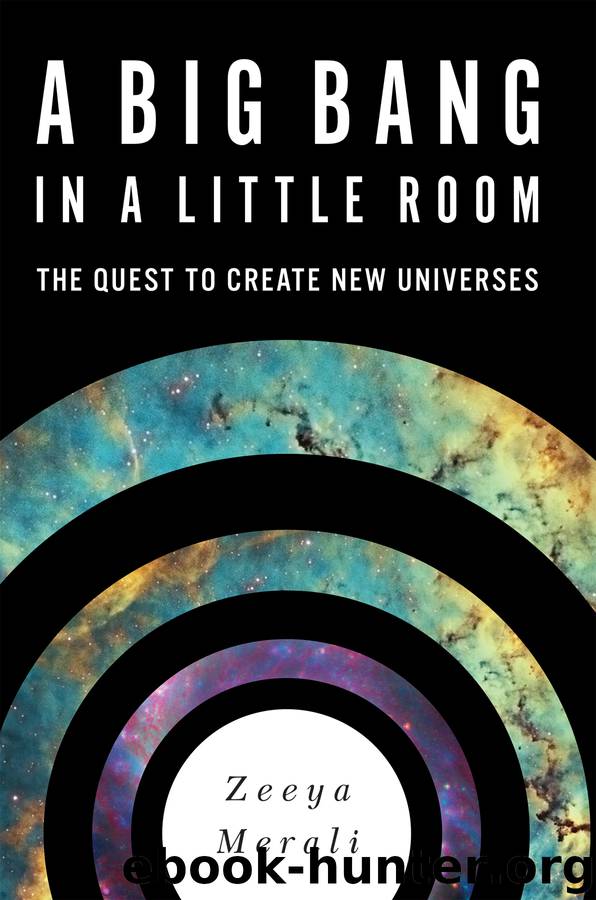A Big Bang in a Little Room: In a Little Room: The Quest to Create New Universes by Zeeya Merali

Author:Zeeya Merali
Language: eng
Format: epub
Publisher: Basic Books
Published: 2017-02-13T16:00:00+00:00
6
The Accidental Universe Makers
When you first set eyes on the ATLAS detector, the largest experiment housed along the 27-kilometer tunnel of the Large Hadron Collider, you are immediately struck by its vast size and its immense beauty. On my first visit to the particle accelerator, which is run by the CERN laboratory, located on the border between Switzerland and France, back in 2009, Sergio Bertolucci, then CERN’s research director, urged me to visit the LHC’s subterranean heart before it was closed off for data taking. “It’s magnificent,” he said, “like standing within a cathedral.”
ATLAS is one of four experiments dotted around the LHC’s circular track. The apparatus stands 25 meters high, about the size of a tall apartment building, and weighs 7,000 tons. Its octagonal symmetry and the vivid colors of the wires, magnet casings, and superconducting devices that form the detection chamber call to my mind Middle Eastern mosques, which are decorated with bright geometric tessellations because Islam forbids icons of people or God. I quietly wonder what archeologists excavating the site far in the future will ascribe as the purpose of the LHC: science or sanctuary?
The LHC has been dubbed the “big bang machine”—but it was not designed to make the baby universes described in this book. Instead, it earned the nickname because it seeks to probe the physics that takes place at high cosmic energies soon after the big bang, but not at our universe’s actual birth. The fact that according to some physicists it may one day be possible to actually make a universe in a particle accelerator is a happy coincidence.
To rev particles up to these colossal energies, the LHC accelerates them to close to the speed of light and then injects them in two beams that travel in opposite directions around its circular track. These beams cross at four points on the circuit; the ATLAS detector is situated at one of those meeting points, and three other experiments (CMS, ALICE, and LHCb) stand at the others, each hunting for a cornucopia of exotic new entities. It’s in these collision zones that energies rage high enough to generate particles and objects that were seen in our infant cosmos.
In 2012, to worldwide fanfare, LHC physicists announced that they had succeeded in creating the Higgs boson, the one remaining puzzle piece in the standard model of particle physics. That theoretical framework had been more or less sketched out by the end of the 1970s, and encompasses three families of particles: the leptons, including electrons and neutrinos; the quarks, which bind together to form protons and neutrons in atomic nuclei and can also come together to form other, less familiar particles; and the bosons, including the particle of light, the photon.
The bosons can act as mediators between other particles, and by so doing, they transmit force. On a microscopic level, physicists picture the electromagnetic force between two electrically-charged particles as being carried by the constant exchange of photons between the pair, either bringing them together or pushing them apart.
Download
This site does not store any files on its server. We only index and link to content provided by other sites. Please contact the content providers to delete copyright contents if any and email us, we'll remove relevant links or contents immediately.
The Complete Stick Figure Physics Tutorials by Allen Sarah(7307)
Secrets of Antigravity Propulsion: Tesla, UFOs, and Classified Aerospace Technology by Ph.D. Paul A. Laviolette(5309)
Thing Explainer by Randall Munroe(3877)
The River of Consciousness by Oliver Sacks(3536)
The Order of Time by Carlo Rovelli(3145)
How To by Randall Munroe(3033)
A Brief History of Time by Stephen Hawking(2960)
I Live in the Future & Here's How It Works by Nick Bilton(2935)
The Great Unknown by Marcus du Sautoy(2646)
What If?: Serious Scientific Answers to Absurd Hypothetical Questions by Randall Munroe(2637)
Midnight in Chernobyl by Adam Higginbotham(2483)
Blockchain: Ultimate Step By Step Guide To Understanding Blockchain Technology, Bitcoin Creation, and the future of Money (Novice to Expert) by Keizer Söze(2445)
Networks: An Introduction by Newman Mark(2360)
The Meaning of it All by Richard Feynman(2299)
Easy Electronics by Charles Platt(2281)
The Tao of Physics by Fritjof Capra(2229)
Midnight in Chernobyl: The Untold Story of the World's Greatest Nuclear Disaster by Adam Higginbotham(2177)
When by Daniel H Pink(2082)
Introducing Relativity by Bruce Bassett(2076)
